Real-time stereo matching with enhanced geometric comprehension through cross-attention integration
IF 5.5
2区 计算机科学
Q1 COMPUTER SCIENCE, ARTIFICIAL INTELLIGENCE
引用次数: 0
Abstract
Accurate disparity estimation through stereo matching remains a critical challenge, especially for real-time applications. This work introduces a novel and computationally efficient framework that achieves high accuracy and real-time performance in stereo-based disparity estimation. The proposed approach introduces three key innovations. This work proposes a context cross-attention (CCA) module, which enhances the cost volume aggregation process by leveraging localized cross-attention for improved geometric understanding. Guided concatenation volume (GCV) is also implemented, which optimizes feature matching by effectively combining correlation clues with contextual information, reducing computational redundancy while maintaining crucial spatial details. Also, this paper proposes an uncertainty-based refinement (UR) module, which improves accuracy in challenging scenarios by utilizing an uncertainty map, a context feature map, and a geometry feature map to correct errors in challenging areas such as textureless regions and occlusions. Comprehensive experiments on multiple benchmark datasets, including KITTI, Sceneflow, Middlebury, and ETH3D, demonstrate that the proposed model performs better than existing state-of-the-art real-time approaches in accuracy metrics while maintaining comparable computational efficiency. These results establish the framework as a viable solution for demanding real-world applications, particularly in autonomous driving and robotics systems where real-time performance is crucial. The source code is available at https://github.com/kayhan-hashemi/CCAStereo.
通过立体匹配进行精确的差异估计仍然是一项严峻的挑战,尤其是对于实时应用而言。这项工作引入了一个新颖、计算高效的框架,可在基于立体的差异估计中实现高精度和实时性。所提出的方法引入了三项关键创新。这项工作提出了一个上下文交叉注意(CCA)模块,该模块通过利用局部交叉注意来提高几何理解能力,从而增强了成本体积聚合过程。此外,还实现了引导连接卷(GCV),通过有效结合相关线索和上下文信息来优化特征匹配,从而在保持关键空间细节的同时减少计算冗余。此外,本文还提出了基于不确定性的细化(UR)模块,通过利用不确定性图、上下文特征图和几何特征图来纠正无纹理区域和遮挡等挑战性区域的错误,从而提高挑战性场景下的准确性。在多个基准数据集(包括 KITTI、Sceneflow、Middlebury 和 ETH3D)上进行的综合实验表明,所提出的模型在精度指标上优于现有的最先进实时方法,同时保持了相当的计算效率。这些结果确立了该框架在要求苛刻的现实世界应用中的可行解决方案,特别是在对实时性要求极高的自动驾驶和机器人系统中。源代码见 https://github.com/kayhan-hashemi/CCAStereo。
本文章由计算机程序翻译,如有差异,请以英文原文为准。
求助全文
约1分钟内获得全文
求助全文
来源期刊

Neurocomputing
工程技术-计算机:人工智能
CiteScore
13.10
自引率
10.00%
发文量
1382
审稿时长
70 days
期刊介绍:
Neurocomputing publishes articles describing recent fundamental contributions in the field of neurocomputing. Neurocomputing theory, practice and applications are the essential topics being covered.
 求助内容:
求助内容: 应助结果提醒方式:
应助结果提醒方式:


